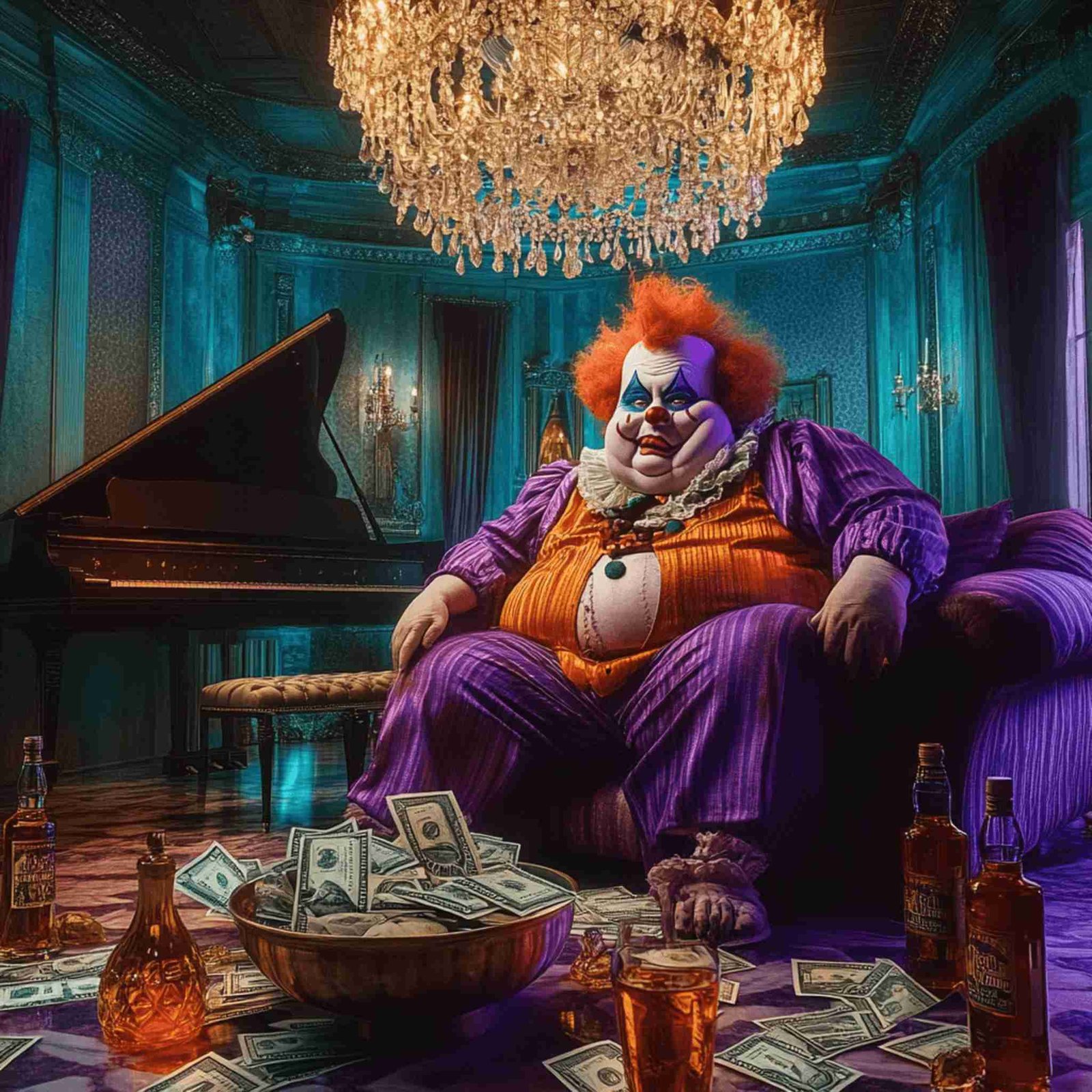Description
Introduction to the Work of Art:
The room is filled with the glow of a grand chandelier, illuminating opulence but casting long, deep shadows across a scene that feels more tragic than triumphant. In the center, a clown reclines on a luxurious couch—his bloated form adorned in an over-the-top, striped purple suit, bright orange accents, and wild red hair, contrasting sharply with the classical grandeur of the room. The clown holds a vacant expression, the familiar garish smile of his painted face making him more unsettling than joyful. At his feet are piles of cash, bottles of whiskey, and a large bowl of overflowing currency—a parody of wealth and excess.
This is Avaritia facit bardus AZ33, a striking piece from AZAD 777781’s collection Avaritia facit bardus, which serves as a powerful allegory for human greed, indulgence, and the hollow pursuit of wealth. The title, translating from Latin as “Greed makes fools,” captures the central theme of the work: the foolishness of the endless chase for materialism, at the cost of meaning and fulfillment. The figure of the clown, with his artificial joy and exaggerated body, becomes a tragic symbol of this pursuit—entangled in riches yet devoid of purpose or satisfaction.
AZAD’s Avaritia facit bardus AZ33 is a masterful fusion of digital artistry and traditional painting, creating a surreal yet vivid portrait that invites viewers to reflect on the perils of excess and the emptiness it often conceals. This unique and original piece, measuring 100 cm by 100 cm, is a captivating example of AZAD’s ability to use mixed media to blur the lines between fantasy and reality, offering a mirror to our own desires and obsessions.
Exhibition Introduction: A Kingdom of Wealth, A Prison of Emptiness
Step into the gilded cage of human desire, where wealth flows like whiskey and every dollar is a promise of something more—yet the eyes of the clown reflect nothing but vacancy. In Avaritia facit bardus AZ33, AZAD 777781 invites us into a world where riches and power hold center stage, but behind the curtain, there is only despair and isolation.
In this piece, AZAD creates an environment that feels regal yet claustrophobic. The rich turquoise walls, the grand chandelier, and the piano in the background all suggest a life of luxury and refinement, but the clown—at once central and out of place—disrupts this fantasy. His grotesque form, clad in exaggerated, ridiculous clothing, seems to mock the elegance of his surroundings, turning what could be a palace into a circus of human folly.
The clown, often a symbol of joy and entertainment, here becomes an emblem of sorrow and absurdity. His oversized body and garish face paint feel like a mask hiding deeper truths, as his painted smile does nothing to disguise the emptiness in his eyes. The piles of cash and bottles of whiskey scattered around him create an image of indulgence, but there is no sense of satisfaction or joy—only a sense of weariness, as though the clown has long realized the futility of his desires but continues to indulge out of habit or compulsion.
The exhibition invites viewers to engage with these contradictions. We are drawn in by the beauty and grandeur of the scene, but repelled by the hollow figure at its center. AZAD uses the clown not just as a character, but as a symbol for the ways in which wealth and materialism can corrupt the soul, turning what should be a life of abundance into a prison of superficiality.
Art Critique: Technique, Influence, and Meaning
AZAD’s Avaritia facit bardus AZ33 is a stunning example of his mastery over both digital and traditional techniques. The piece feels rich in texture and depth, with every element—from the plush fabric of the couch to the gleaming surface of the chandelier—rendered with a meticulous attention to detail. The lighting, soft and warm yet heavy with shadows, creates an atmosphere of decadence that feels suffocating rather than inviting.
The influence of 20th-century illustrators and expressionists is clear in AZAD’s work. There are strong echoes of George Grosz and Otto Dix, particularly in the grotesque exaggeration of the human form and the sharp critique of wealth and power. Like Grosz and Dix, AZAD uses caricature not just for humor but for social commentary, exposing the moral and emotional decay that often accompanies material excess. The clown’s swollen form, painted face, and garish costume all serve as visual metaphors for the ways in which wealth distorts and dehumanizes.
The clown’s face, despite its exaggerated features, feels tragically human. His painted-on joy is contrasted by the heaviness of his body and the empty look in his eyes, reminding viewers that wealth and indulgence are often masks for deeper unhappiness. The whiskey bottles scattered at his feet—symbols of vice and temporary pleasure—only reinforce the idea that the pursuit of excess is ultimately hollow.
In comparison to the work of American illustrators like Norman Rockwell, AZAD’s portrayal of life is a dark inversion. Where Rockwell’s characters often embody the idealized American dream, AZAD’s clown is the embodiment of its nightmare—trapped in a world of wealth, yet devoid of meaning. While Rockwell’s works are filled with warmth and sincerity, AZAD’s Avaritia facit bardus AZ33 is a sharp critique of the darker side of that dream, showing the emptiness that can come from a life spent chasing money and material success.
The choice of color in this piece is also particularly striking. The rich purples and oranges of the clown’s costume clash with the more subdued blues and golds of the room, creating a visual tension that reflects the underlying tension in the scene. The clown’s flamboyant appearance seems at odds with his surroundings, suggesting that he does not truly belong in this world of luxury, but has forced his way into it through excess and greed.
Artistic Critic Presentation: The Vision of AZAD 777781
AZAD 777781 is a digital artist who has gained international acclaim for his ability to explore the deepest fears, desires, and obsessions of the human psyche. His work, which often features exaggerated, surreal figures, is a reflection of the anxieties and struggles that define the human experience, particularly in relation to power, wealth, and materialism. AZAD’s art is a blend of the grotesque and the beautiful, using distortion and exaggeration to reveal the hidden truths of society and the individual.
What sets AZAD apart from other contemporary artists is his ability to create works that are both visually arresting and conceptually profound. His clowns, while often ridiculous and absurd, are also deeply tragic figures, reflecting the ways in which society’s obsession with wealth and power can distort our humanity. In Avaritia facit bardus AZ33, the clown is not just a figure of mockery, but also one of empathy. We see in his exaggerated form the consequences of living a life consumed by greed and excess, and in his vacant expression, we recognize the deep loneliness and despair that often accompanies such a life.
AZAD’s use of digital techniques allows him to create works that feel both fantastical and hyper-realistic. His ability to manipulate light, texture, and color gives his pieces a sense of depth and immersion, drawing viewers into the world he has created. In Avaritia facit bardus AZ33, every detail—from the gleam of the chandelier to the worn expression on the clown’s face—feels meticulously crafted, creating a work that is as much about the atmosphere as it is about the central figure.
AZAD’s international success can be attributed to the universality of his themes. While his work is often grounded in contemporary issues, such as consumerism and the pursuit of wealth, his clowns are archetypal figures that speak to the timeless nature of human folly. The clown in Avaritia facit bardus AZ33 is not just a product of modern capitalism, but a symbol of the ways in which humanity has always been drawn to excess, often at the cost of its own well-being.
Artistic Critic Presentation: The Poetic Meaning of Avaritia facit bardus AZ33
At its heart, Avaritia facit bardus AZ33 is a meditation on the nature of greed and the emptiness that often accompanies the pursuit of wealth. The clown, seated in a room filled with luxury, is both a king and a fool—surrounded by riches, yet utterly devoid of happiness or meaning. His painted smile, his flamboyant costume, and the piles of cash at his feet are all symbols of the ways in which materialism distorts our sense of self, turning us into grotesque caricatures of who we truly are.
The whiskey bottles scattered around the room are particularly symbolic. Alcohol, often associated with pleasure and indulgence, becomes in this context a symbol of excess and self-destruction. The clown’s relationship with the whiskey—just as with the money—is one of dependency, as though he is using these material comforts to fill a void that they can never truly satisfy. The more he drinks, the more he indulges, the further he falls into the spiral of greed and self-destruction. The grand piano in the background serves as an interesting counterpoint to the rest of the scene. A symbol of culture, art, and refinement, the piano feels out of place in this world of indulgence and excess. It suggests that the clown, despite his wealth, has no connection to the deeper, more meaningful aspects of life—such as art, beauty, and creativity. Instead, he is trapped in a cycle of consumption and pleasure-seeking, cut off from the things that might actually bring him fulfillment.
The chandelier, which dominates the room with its overwhelming light, serves as both a symbol of power and a reminder of the artificiality of the scene. The light it casts is harsh and unforgiving, exposing every detail of the clown’s ridiculousness and emphasizing the emptiness of his wealth. The chandelier, like the money and the whiskey, is a symbol of excess, but it is also a reminder that all the material wealth in the world cannot hide the deeper truths of loneliness and despair.
Through Avaritia facit bardus AZ33, AZAD encourages viewers to reflect on their own relationship with wealth and power. The clown, though grotesque and exaggerated, is a reflection of our own desires and obsessions. We see in him the consequences of living a life consumed by materialism, and in his empty expression, we recognize the truth that wealth alone cannot bring happiness.
Conclusion: The Power of Art to Reflect Human Folly
In Avaritia facit bardus AZ33, AZAD 777781 has created a work that is both visually stunning and deeply philosophical. The clown, surrounded by wealth and indulgence, becomes a symbol of the human condition—trapped in a world of excess, yet forever longing for something more. Through his masterful use of color, light, and texture, AZAD has created a work that speaks to the deepest fears, desires, and obsessions of modern life.
This work is not just a critique of greed and materialism; it is a reflection on the deeper human desire for meaning, connection, and fulfillment. The clown’s painted smile and the empty bottles at his feet serve as reminders that no amount of wealth or indulgence can satisfy the deeper needs of the soul. AZAD’s ability to express these complex themes through his unique visual language is what makes him one of the most compelling artists of our time.
Through Avaritia facit bardus AZ33, AZAD challenges us to look beyond the surface of our own lives, to question the values and desires that drive us, and to recognize the foolishness that often accompanies the pursuit of wealth. It is a work that invites deep reflection and offers no easy answers, but it is in this complexity that the true power of AZAD’s art lies.





